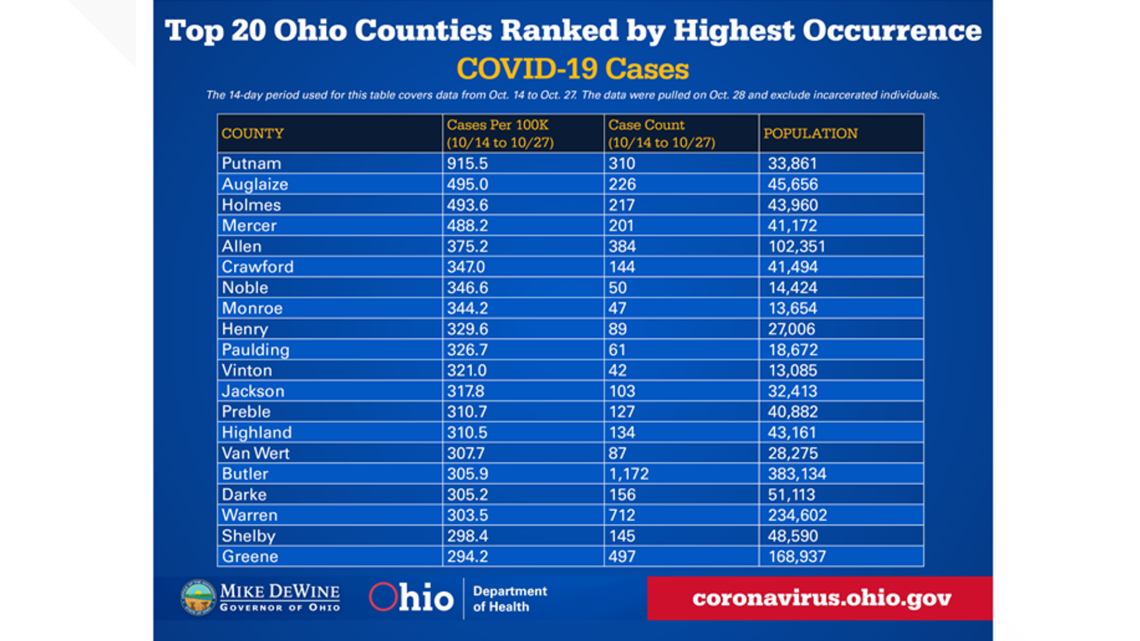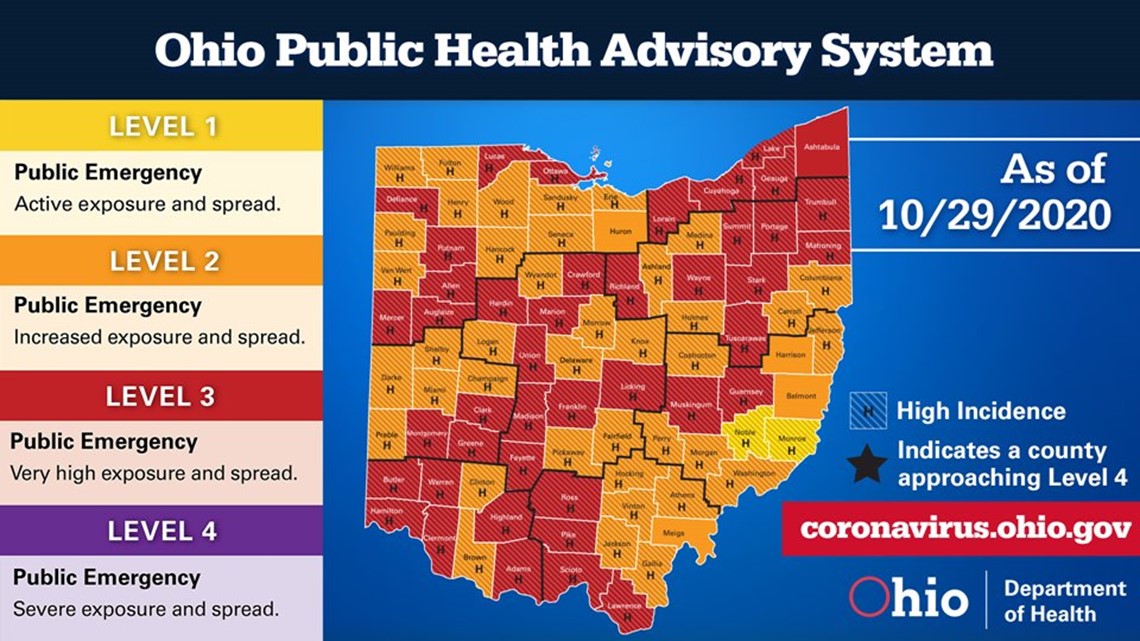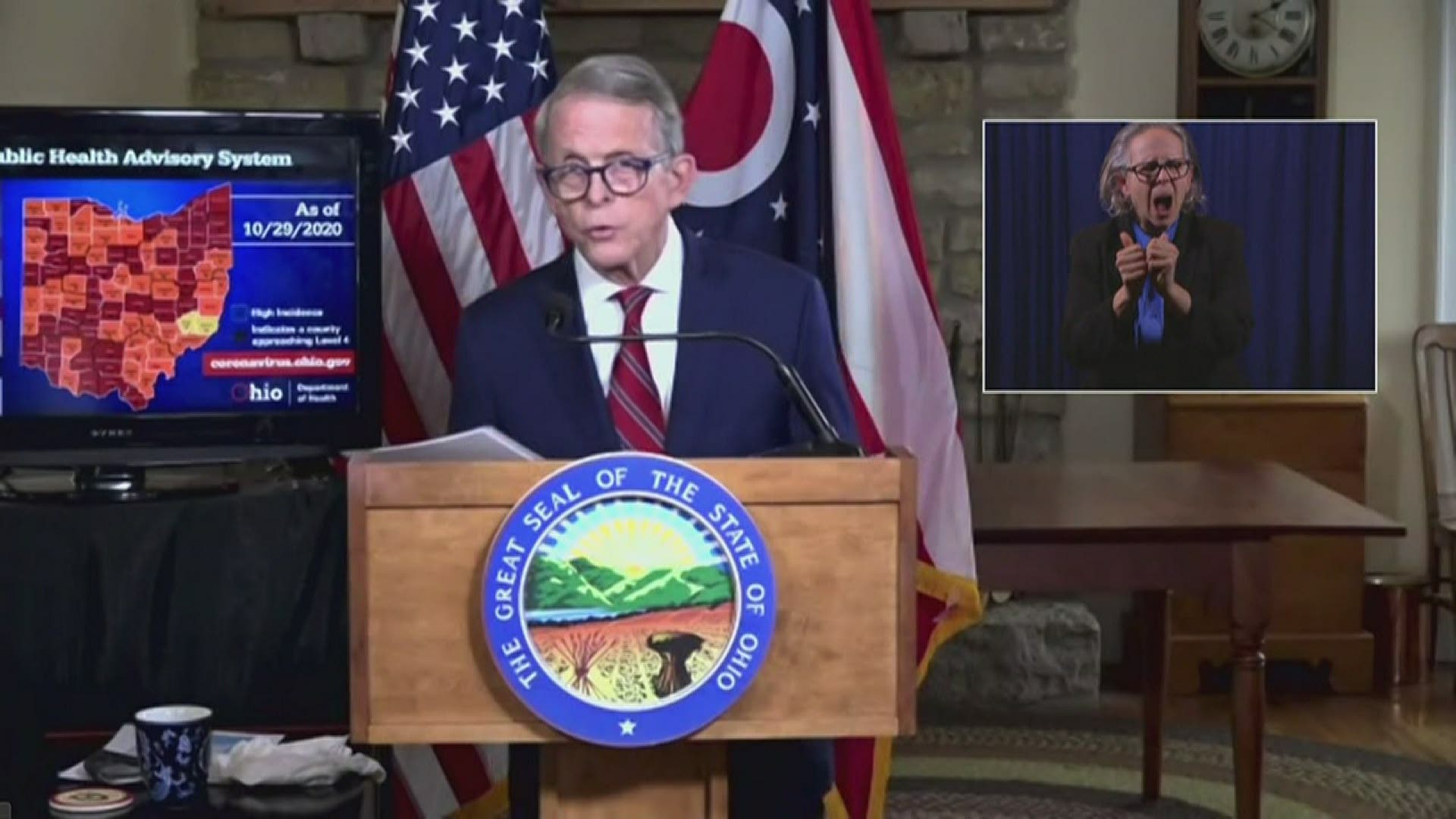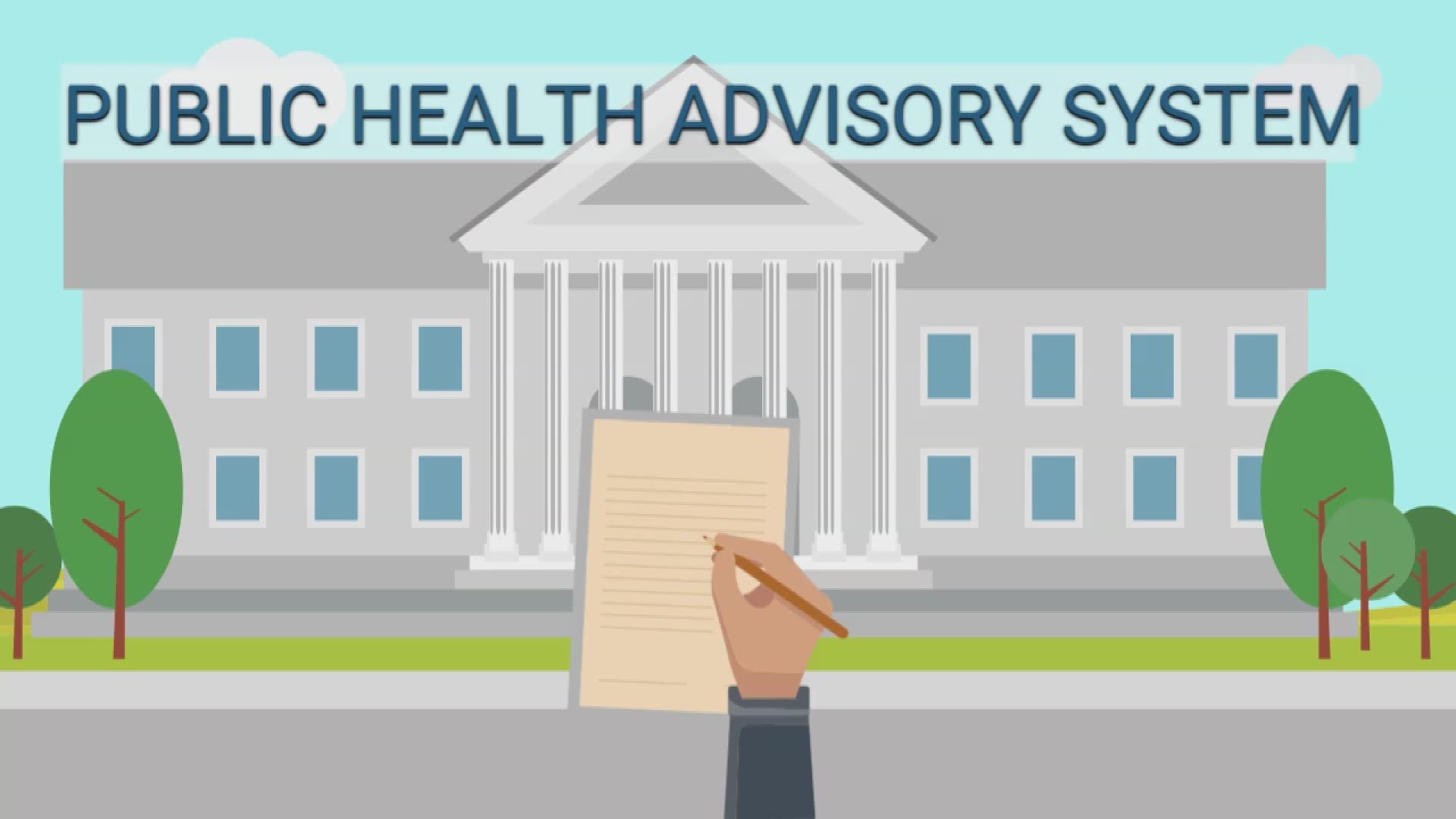COLUMBUS, Ohio — The state of Ohio shattered its previous record for most COVID-19 cases in a 24-hour period Thursday, reporting 3,590 since Wednesday.
Ohio Gov. Mike DeWine said at his regular coronavirus press conference that this number is 25% higher than the state's second-highest daily increase set just this past Saturday.
"There's no place to hide," DeWine said.
There are now only two counties in the Level 1 (Yellow) category and only five are not considered high incidence. The governor once again pushed Ohioans toward a united front to combat the increased spread.
"We all have to come together to fight this enemy," DeWine said.
The governor said that we have tools to fight the virus: good ventilation, mask use, hand washing and distance.
"We have to get back to the fundamentals. We have to get back to the basics," he said.
Despite the data, DeWine said he is optimistic, explaining that we have the tools to stop the spread and that the decisions we make each day will determine the winter, a sentiment he has repeated at nearly all of his recent conferences.
"We can control our own destiny," he said.
KEY INDICATORS
On Thursday, the Ohio Dept. of Health reported:
- 3,590 new cases of coronavirus compared to the 21-day average of 2,127
- 19 deaths compared to the 21-day average of 14
- 194 new hospitalizations compared to the 21-day average of 124
- 26 ICU admissions compared to the 21-day average of 20
Thursday broke another record with the highest 24-hour increase since the pandemic began. It also brought the third-highest 24-hour increase in hospitalizations. According to DeWine, the top five dates with the highest daily hospitalization numbers have all occurred in the last week and a half.
DeWine said that while spread does occur in bars, schools and at work, it seems to be less frequent in these formal settings. He has continued to say, alongside health professionals, that spread is most often occurring at private, informal gatherings.
It is natural for people let their guard down around friends and family, but if they are not in your regular bubble, distancing and mask use should still be in practice, DeWine said.
"This is not rocket science. This isn't difficult. We just need to do it," he said.
CASES PER 100,000
On Thursday, 83 of Ohio's 88 counties were considered high incidence counties. The Center for Disease Control and Prevention (CDC) defines high incidence as 100 cases per 100,000 people. The Ohio Dept. of Health has put together daily rankings of each county in order of those with the most cases per 100,000 to the least.
Putnam County has stayed at the top of that list for weeks, and on Thursday, the level of spread jumped up to 915.5 cases per 100,000 people in the county - more than nine times the CDC threshold.
Also in northwest Ohio, Henry County came in ninth, with 329.6 cases per 100,000 and Paulding came in tenth with 326.7 cases per 100,000 people.


PUBLIC HEALTH ADVISORY MAP
The bright spot during Thursday's conference was the fact that no counties upgraded to purple.
However, 43 out of the state's 88 counties were at Level 3 (Red) and only two were at Level 1 (Yellow). DeWine said this is the highest number of "red" and the lowest number of "yellow" counties since the system's inception.
Currently, 78% of Ohioans live in a "red" county, with less than 1% living in a county that is "yellow."
In northwest Ohio, Defiance County jumped to "red," joining Lucas, Ottawa and Putnam.


Three counties did drop off DeWine's watch list Thursday. He explained that because of the way the system is designed, a county has to accelerate and the indicators have to actively worsen before it moves to Level 4 (Purple). As of Thursday, those counties have plateaued and removed from the watch list.
However, just because the counties were removed from that list, DeWine said there it doesn't mean there isn't a lingering concern.
"What we see in these three counties is similar to what we see in the rest of the state—case numbers are continuing to go up, and healthcare utilization is trending upward. This is concerning. This is not good," he said.
COVID-19 DEFENSE TEAMS
DeWine called on all counties have to come together to form a COVID-19 defense team. These teams should include local hospital leaders, mayors, business leaders and others. He said it should be representative of their community and should assess and understands their situation as well as their individual assets.
"Because we now know what works to fight the virus, a major part of their job will be to explain to the people in the community exactly what is going on in the community," he said.
DeWine said that each county has committed to expanding its working group to include more people with weekly meetings.
The governor compared the response to COVID-19 to that of natural disasters, calling on Ohioans to come together.
"This is a crisis that is grave, certainly, and much more widespread," he said.
DeWine said things happen at a local level. He's learned that someone who is disinterested in wearing a mask is a lot more likely to listen to a neighbor than they are to him or other leaders at a state or even national level.
ELECTION
DeWine said that if you feel you can go to the grocery store, you should feel safe going to vote. He suggested that Ohioans consider the time of day, if possible, that they head to the polls. Of course, voters should continue to follow the usual protocols: wear a mask, keep a distance and wash their hands.
The governor also noted that nearly half of Ohio's voters will have already cast a ballot by Nov. 3, as early voting continues to greatly outpace the level seen in 2016.
TUESDAY
The governor asked for leaders throughout Ohio's 88 counties to come together and reassess what they are doing to deal with COVID-19.
He also asked that every resident understand the spread within their county.
"If you are in one of the 82 counties that is now a high-incident county, please reconsider hosting or attending gatherings of any size; this includes with friends and extended family," DeWine said.
Along with a reminder of how to properly wear a mask, DeWine also suggested that residents in the 82 counties do not attend any Halloween parties and to think about canceling future events.
He also suggested residents wear masks not only inside, but also outside when social distancing is not possible.
KEY METRICS
On Thursday, the Ohio Dept. of Health reported:
- 2,509 new cases of coronavirus compared to the 21-day average of 1,973
- 22 deaths compared to the 21-day average of 14
- 198 new hospitalizations compared to the 21-day average of 117
- 20 new ICU admissions compared to the 21-day average of 19
DEWINE TO MEET WITH COUNTY LEADERS
DeWine also announced that starting Tuesday, he will begin meeting with the counties to discuss how his administration can help beat this virus.
The first three counties DeWine plans to meet with are the counties that are on the watch list. He then will start with the county with the most cases per 100,000 people. As of Tuesday, that county is Putnam County.
LAST WEEK
Ohio Gov. Mike DeWine called for unity at Thursday's coronavirus press conference, asking all Ohioans to be "fully engaged" in the fight against COVID-19.
"For my fellow Ohioans who felt that, until now, this virus really didn't impact their life, did not impact their family and who have said, 'I'll pay attention when it gets serious. I'll pay attention when it threatens me and my family,' the message to them today is: it is now serious and it is time for all of us to come together," DeWine said.
While the governor maintained a serious tone through much of his conference, he ended things on his usual note of optimism.
"We can turn this around. COVID-19 is multiplying very quickly - and it will continue unless we do something different. More of us need to wear masks, and more of us need to be careful. We've done it before, and we can do it again," DeWine said.
When asked about the potential for another shutdown, as some Ohioans continue to rebuke the current mask order, DeWine said: "There's still time."
The governor has repeatedly said that he has "no plans" for another shutdown but noted it would be "irresponsible" of him to say it is out of the realm of future possibility.
The governor expressed grave concern regarding Ohio's current place in the pandemic but made clear that the government cannot and will not go knocking on doors, checking for parties or looking for masks. However, he called on personal responsibility, saying Ohioans are in a unique position to turn things around.
"Ohioans are pragmatic people: we're tough, we're strong, we're pragmatic, we get serious when it's time to get serious. It's time to get serious," DeWine said.
KEY METRICS
On Thursday, the Ohio Dept. of Health reported:
- 2,425 new cases of coronavirus compared to the 21-day average of 1,672
- 12 deaths compared to the 21-day average of 16
- 159 new hospitalizations compared to the 21-day average of 99
- 25 new ICU admissions compared to the 21-day average of 17
Thursday, once again, broke the record for the highest 24-hour increase in COVID-19 cases since the pandemic began. DeWine said that out of the 10 highest days of new cases reported, eight have been in the last nine days, and nine have occurred this month alone.
"Quite frankly, what is most scary about this is that it doesn't seem like we are even starting to get to a plateau," DeWine said.
Thursday also brought the third-highest increase in hospitalizations. The highest was recorded on Tuesday with 216.
DeWine called hospitalizations the most important indicator we had, noting it has been steadily increasing over the last few weeks.
On Oct. 9, there were 853 COVID-19 patients in hospitals. On Thursday, that number grew to 1,293.
Many critics of the governor claim that an increase in testing is to blame for the state's jump in COVID-19 cases. However, DeWine argued that there are a number of factors indicating that testing is not the sole cause of the spike.
"The whole idea that our cases are going up solely because of the increase in testing is just nuts," DeWine said.
The governor pointed toward the state's increase in test positivity, which has more than doubled from what it was three weeks ago.
Generally, he said, as you test a wider group of people, including those without symptoms, you would expect cases to go down. However, that is not what health experts are seeing in Ohio.
CASES PER 100,000 PEOPLE
The Centers for Disease Control and Prevention's (CDC) threshold for high incidence is 100 cases per 100,000 people. On Thursday, the vast majority of Ohio's 88 counties met or exceeded that number.
Putnam County once again topped DeWine's list ranking counties in order of those with the most cases per 100,000 to the least, with 549 cases per 100,000. That number is just short of five-and-a-half times the CDC threshold.
The only northwest Ohio county that was below the threshold Thursday was Huron, with 89 cases per 100,000.
Fulton County was in the top 20, with 263.5 cases per 100,000 people, more than two-and-a-half times the threshold for high incidence.
PUBLIC HEALTH ADVISORY MAP
DeWine said that there were 38 counties now in the Level 3 (Red) category of the state's Public Health Advisory System, with three counties on the watch list and on the brink of increasing to Level 4 (Purple). No county has reached the purple category since the map's inception.
Locally, Lucas, Putnam and Ottawa were listed at Level 3 (Red).
Ottawa County was added to the list for the first time in months. DeWine attributed the move to the fact that Ottawa has exceeded the CDC’s threshold for high incidence and is now seeing a sustained increase in new cases.
Health department officials reported that the county has had more than 90 cases to date in Oct., triple the number of cases the county had in Sept.
At this point, there are only four counties in the Level 1 (Yellow) category, only 1% of the population. DeWine said that 74% of Ohioans are now living in a county that is at Level 3 (Red).
Health officials noted that Ohioans seem to be getting tired of COVID-19 restrictions and letting their guards down in terms of mask compliance and social distancing.
WHAT HAPPENS WHEN A COUNTY TURNS PURPLE?
DeWine made clear Thursday that there is no current mandate from the state that dictates what Ohioans have to do when their county turns purple. However, there is guidance, providing best practices and things to keep in mind if a county hits that level.
Here is a breakdown of each level in the state's Public Health Advisory System:
1. LEVEL 1 YELLOW ALERT (active exposure and spread):
- Conduct a daily health/symptom self-evaluation and stay at home if
- symptomatic.**
- Maintain social distancing of at least 6 feet from non-household members.
- Wear face coverings in public, especially when social distancing is difficult to maintain.
- Increase caution when interacting with others not practicing social distancing or wearing face covers.
- Avoid traveling to high-risk areas.
- Follow good hygiene standards, including:
- Wash hands frequently with soap and water for at least 20 seconds.
- Use hand sanitizer frequently.
- Avoid touching your face.
- Cover coughs or sneezes (e.g., into a tissue, or elbow).
- Symptom self-evaluation monitoring
2. LEVEL 2 ORANGE ALERT (increased exposure and spread; exercise high degree of caution):
Same guidelines as in Level 1.
- Avoid contact with anyone who is considered high-risk.
- High-risk individuals* should take extra care to follow precautions.
- Decrease in-person interactions outside household.
- Seek medical care as needed, but limit or avoid unnecessary visits to hospitals, nursing homes, and residential care facilities to see others as much as possible.
3. LEVEL 3 RED ALERT (very high exposure and spread; limit activities as much as possible)
Same guidelines as in Levels 1-2.
- Decrease in-person interactions with others.
- Consider necessary travel only.
- Limit attending gatherings of any number
4. LEVEL 4 PURPLE ALERT (severe exposure and spread; only leave home for supplies and services)
Same guidelines as in Level 1-3.
- Stay at home/ necessary travel only.
The governor encouraged people to look at both the map, and the list ranking counties based on cases per 100,000 people to make informed decisions as they go about their lives.
"Look at where you are. That really tells you what your odds are of running into someone who has it," DeWine said.
The three counties on the "watch list," DeWine said, all currently qualify as purple right now. However, due to the way the system is set up, a county needs to meet those qualifiers two weeks in a row to actually be raised to Level 4 (Purple) on the map.
SCHOOLS
Over the past two weeks, DeWine has expressed concerns regarding the future of schools in Ohio.
He has claimed on a number of occasions that what is reflected in schools, as far as COVID-19 spread - depends on what's happening in the community.
"If you have four times the spread in the community, you are almost bound to have spread in your schools," DeWine said.
He expressed the continued belief that Ohio schools are doing a good job in keep staff and students safe. He said that from what health officials have observed, there is not significant spread within school buildings, rather, the spread is occurring when people are away from the more formal setting.
DeWine also said that while some students will thrive no matter how they are taught, there are many who don't and a lot of students don't thrive in a remote situation.
He said that, as governor, he is bothered by kids being out of school this long.
DeWine called on educators and superintendents to take these factors into consideration, reminding Ohioans that these are individual decisions.
The governor alluded to a study that will be conducted within Ohio schools in which students will be tested, with consent from schools and parents, both after exposure and at random.
Results would not be available until a month after the study is conducted. More information is expected in the coming weeks.
FORMER NEW JERSEY GOV. CHRIS CHRISTIE ON HIS EXPERIENCE WITH COVID-19
Former New Jersey Gov. Chris Christie joined in on Tuesday's presser after fighting a tough battle with coronavirus himself. Since his diagnosis, Christie has been vocal about the importance of masks to prevent further spread.
"I thought I was safe and I was wrong," Christie said.
The former governor noted that he had been tested every day that he stepped on the White House grounds as he prepped President Donald Trump for his debate against Democratic opponent Joe Biden.
He said he was assured that sitting in the third row at the Rose Garden Ceremony for Amy Coney Barrett, that everyone in front of him had tested negative that day.
"And so, I took my mask off," he said.
He said his mask was off only during the time he was in those gates. However, three days later, he felt what he referred to the "freight train" of COVID-19 symptoms: fever, headaches, body aches, chills and sweats.
In 24 hours, he went from feeling fine and doing his work, to going to the hospital and being admitted to the intensive care unit for six days.
"I want everyone out there to understand that this is one of the most unpredictable, random and brutal viruses out there," Christie said.
He encouraged Ohioans to follow CDC guidelines: wash their hands, wear their masks and keep their distance from others.
"Don't let your guard down. It's not worth it," he said.
He noted that he was in isolation, with glass so thick that he couldn't hear nurses. They communicated mostly by whiteboards.
"You're just left alone with your thoughts," Christie said.
He called the combination of physical and emotional stress a first in his life. Christie said that while we are all sick of this, the small actions we can take every day can make a big difference.


